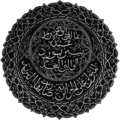Tenure Incumbent Notes Portrait 4 November 1848 to 22 October 1850 Viala Charon , 22 October 1850 to 10 May 1851 Alphonse Henri, comte d'Hautpoul , 10 May 1851 to 11 December 1851 Aimable -Jean-Jacques Pélissier 1st term 11 December 1851 to 31 August 1858 Jacques Louis Randon , 24 June 1858 to 21 March 1859 Prince Napoléon-Joseph-Charles-Paul Bonaparte 21 March 1859 to 24 November 1860 Prosper, comte de Chasseloup-Laubat , 24 November 1860 to 22 May 1864 Aimable -Jean-Jacques Pélissier 2nd term 22 May 1864 to 1 September 1864 Edmond-Charles de Martimprey , 1 September 1864 to 27 July 1870 Patrice de MacMahon, duc de Magenta , 27 July 1870 to 23 October 1870 Louis, Baron Durieu , 23 October 1870 to 24 October 1870 Jean Walsin-Esterhazy [ fr ] , 24 October 1870 to 16 November 1870 Henry-Gabriel Didier [ fr ] , 16 November 1870 to 8 February 1871 Charles de Bouzet , c. November 1870 to March 1871 Romuald Vuillermoz [ fr ] , Mayor of Algiers and Head of the Committee of Defence In rebellion 8 February 1871 to 21 March 1871 Alexis Lambert [ fr ] , 21 March 1871 to 10 June 1873 Louis Henri de Gueydon , 10 June 1873 to 15 March 1879 Antoine -Eugène-Alfred Chanzy 15 March 1879 to 26 November 1881 Albert Grévy , 26 November 1881 to 18 April 1891 Louis Tirman , 18 April 1891 to 28 September 1897 Jules Cambon , 28 September 1897 to 1 October 1897 Henri-Auguste Lozé , 1 October 1897 to 26 July 1898 Louis Lépine , 26 July 1898 to 3 October 1900 Édouard Laferrière , 3 October 1900 to 18 June 1901 Charles Jonnart , 1st term 18 June 1901 to 11 April 1903 Paul Révoil , 11 April 1903 to 5 May 1903 Maurice Varnier [ fr ] , 5 May 1903 to 22 May 1911 Charles Jonnart , 2nd term 22 May 1911 to 29 January 1918 Charles Lutaud , 29 January 1918 to 29 August 1919 Charles Jonnart , 3rd term 29 August 1919 to 28 July 1921 Jean-Baptiste Eugène Abel 28 July 1921 to 17 April 1925 Théodore Steeg , 17 April 1925 to 12 May 1925 Henri Dubief , 12 May 1925 to 20 November 1927 Maurice Viollette , 20 November 1927 to 3 October 1930 Pierre-Louis Bordes [ fr ] , 3 October 1930 to 21 September 1935 Jules Carde , 21 September 1935 to 19 July 1940 Georges Le Beau [ de ] , 19 July 1940 to 16 July 1941 Jean-Marie Charles Abrial , 16 July 1941 to 20 September 1941 Maxime Weygand , 20 September 1941 to 20 January 1943 Yves-Charles Châtel [ fr ] , 20 January 1943 to 3 June 1943 Bernard-Marcel -Edmond Peyrouton , 3 June 1943 to 8 September 1944 Georges Albert Julien Catroux 1st term 8 September 1944 to 11 February 1948 Yves Chataigneau , 11 February 1948 to 9 March 1951 Marcel-Edmond Naegelen , 12 April 1951 to 26 January 1955 Roger Léonard [ fr ] , 26 January 1955 to 1 February 1956 Jacques Soustelle , 1 February 1956 to 9 February 1956 Georges Albert Julien Catroux 2nd term 9 February 1956 to 13 May 1958 Robert Lacoste , 13 May 1958 to 1 June 1958 André Mutter [ fr ] , 13 May 1958 to 23 May 1958 Jacques Massu President of the Committee of Public Safety In rebellion during the May 1958 crisis 23 May 1958 to 7 June 1958 Committee of Public Safety :- Jacques Massu President of the Central Committee of Public Safety Sid Cara President of the Central Committee of Public Safety 7 June 1958 to 12 December 1958 Raoul -Albin-Louis Salan 12 December 1958 to 23 November 1960 Paul Delouvrier , 23 November 1960 to 19 March 1962 Jean Morin [ fr ] , 21 April 1961 to 25 April 1961 Directorate :-In rebellion during the Algiers putsch of 1961 Maurice Challe André Zeller Edmond Jouhaud Raoul Salan 19 March 1962 to 3 July 1962 Christian Fouchet , 3 July 1962 to 25 September 1962 Abderrahmane Farès , 































































